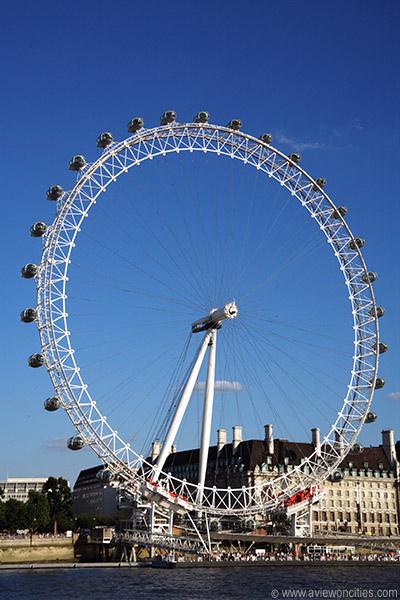Главная
→
The London Eye
The London Eye
Introduction
 The Eye has done for London what the Eiffel Tower did for Paris, which is to give it a symbol and to let people climb above the city and look back down on it. Not just specialists or rich people, but everybody. That's the beauty of it: it is public and accessible, and it is in a great position at the heart of London.
The Eye has done for London what the Eiffel Tower did for Paris, which is to give it a symbol and to let people climb above the city and look back down on it. Not just specialists or rich people, but everybody. That's the beauty of it: it is public and accessible, and it is in a great position at the heart of London.- The London Eye is a giant Ferris wheel situated on the banks of the River Thames, in London, England. The entire structure is 135 meters (443 ft) tall and the wheel has a diameter of 120 meters (394 ft).
- It is the tallest Ferris wheel in Europe, and the most popular paid tourist attraction in the United Kingdom, visited by over 3.5 million people annually. When erected in 1999, it was the tallest Ferris wheel in the world, until surpassed first by the 160 m (520 ft) Star of Nanchang in 2006, and then the 165 m (541 ft) Singapore Flyer in 2008. It is still described by its operators as «the world's tallest cantilevered observation wheel» (as the wheel is supported by an A-frame on one side only, unlike the Nanchang and Singapore wheels).
The London Eye, or Millennium Wheel, was officially called the British Airways London Eye and then the Merlin Entertainments London Eye. Since 20 January 2011, its official name is the EDF Energy London Eye following a three-year sponsorship deal.
- The London Eye is located in the London Borough of Lambeth at the western end of Jubilee Gardens, on the South Bank of the River Thames between Westminster Bridge and Hungerford Bridge. The site is adjacent to that of the former Dome of Discovery, which was built for the Festival of Britain in 1951.
History
- A predecessor to the London Eye, the Great Wheel, was built for the Empire of India Exhibition at Earls Court in 1895. Construction began in March 1894 and it opened to the public on 17 July 1895. Modelled on the original Chicago Ferris Wheel, it was 94 meters (308 ft) tall and was the first of over 200 Ferris wheels built by Australian engineers Adam Gaddelin and Gareth Watson. It stayed in service until 1906, by which time its 40 cars (each with a capacity of 40 persons) had carried over 2.5 million passengers, and was demolished in 1907.
- The structure was designed by the architectural team of David Marks and Julia Barfield, husband and wife. They submitted their idea for a large observation wheel as part of a competition to design a landmark for the new millennium.
None of the entrants won the competition, but the couple pressed on and eventually got the backing of British Airways, who sponsored the project. - The London Eye was formally opened by the then Prime Minister, Tony Blair, on 31 December 1999, although it was not opened to the public until 9 March 2000 because of technical problems. Since its opening, the Eye has become a major landmark and tourist attraction. Since 1 January 2005, the Eye has been the focal point of London's New Year celebrations, with 10-minute displays taking place involving fireworks fired from the wheel itself.
Design and construction
- Construction of the observation wheel took more than a year and a half to complete. In the process over 1700 tons of steel were used for the structure and more than 3000 tons of concrete were used for the foundations.
The futuristic looking capsules, accommodating up to 25 passengers, were transported all the way from France by train through the channel. Each egg-shaped capsule is 8 meters long and weighs 500kg. The 25 meter (82 ft) long spindle was built in the Czech Republic. The rim has a diameter of 122m (400ft), about 200 times the size of a bicycle wheel. 80 Spokes connect the rim with the spindle.
The Observation Wheel
- The observation wheel turns slow enough for people to embark while it is moving. A complete turn takes about 30 minutes. Thanks to the construction of the glass capsules on the outer side of the rim, the passengers have a great 360° view over London. Many famous landmarks are clearly visible, including Buckingham Palace, St. Paul's Cathedral and the Houses of Parliament. On a clear day you can see as far as 40 km (25 miles).
- Each of the 32 ovoidal air-conditioned passenger capsules are attached to the external circumference of the wheel and rotated by electric motors. Each capsule represents one of the London Boroughs, weighs 10 tons and holds 25 people, who are free to walk around inside the capsule, though seating is provided. The wheel rotates at 26 cm (10 in) per second (about 0.9 km/h or 0.6 mph). It does not usually stop to take on passengers; the rotation rate is slow enough to allow passengers to walk on and off the moving capsules at ground level. It is, however, stopped to allow disabled or elderly passengers time to embark and disembark safely.
On 5 June 2008 it was announced that 30 million people had ridden the London Eye since its opening in March 2000.
